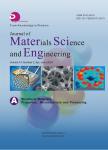PbS Nanostructures Thin Films by in situ PbS:Ni and PbS:Cd-Doping
PbS Nanostructures Thin Films by in situ PbS:Ni and PbS:Cd-Doping作者机构:Faculty of Chemistry Autonomous University of Puebla (UAP) Puebla Mexico Faculty of Electronics Autonomous University of Puebla (UAP) Puebla Mexico
出 版 物:《材料科学与工程(中英文A版)》 (Journal of Materials Science and Engineering A)
年 卷 期:2013年第3卷第5期
页 面:305-314页
学科分类:080903[工学-微电子学与固体电子学] 0809[工学-电子科学与技术(可授工学、理学学位)] 08[工学] 080501[工学-材料物理与化学] 0805[工学-材料科学与工程(可授工学、理学学位)] 080502[工学-材料学] 081202[工学-计算机软件与理论] 0812[工学-计算机科学与技术(可授工学、理学学位)]



